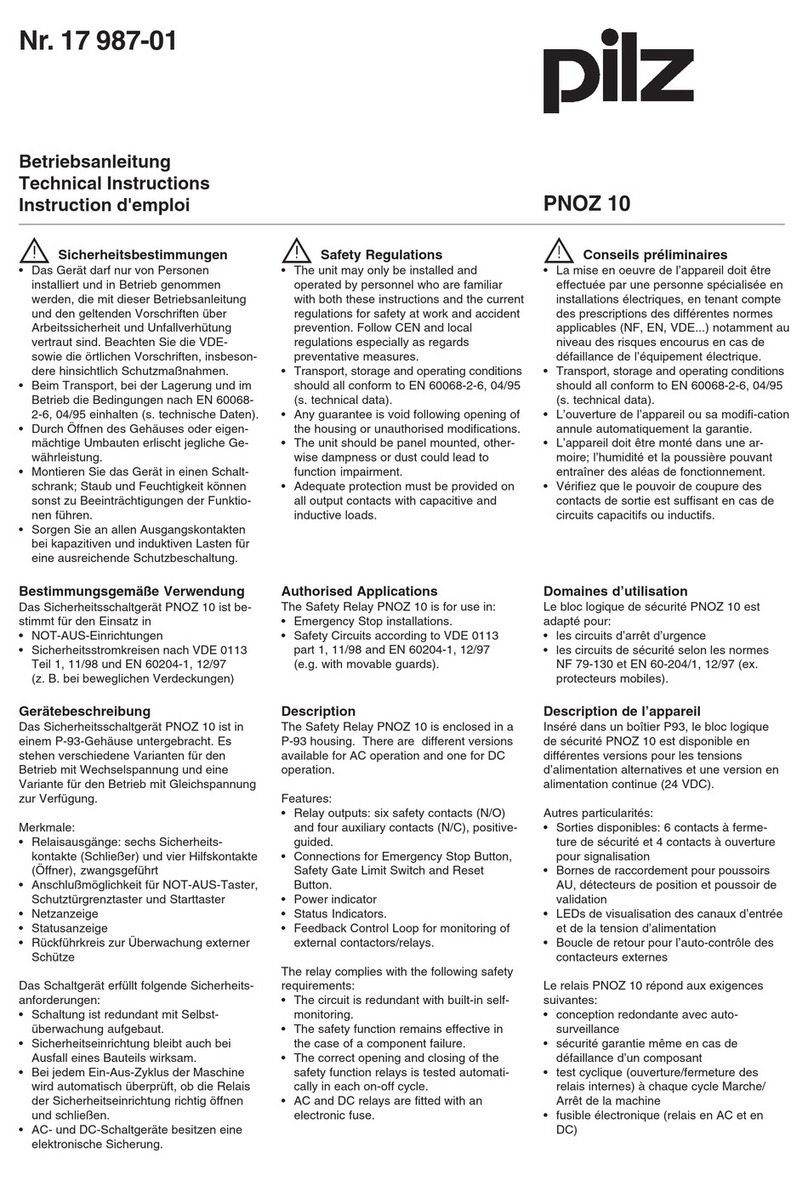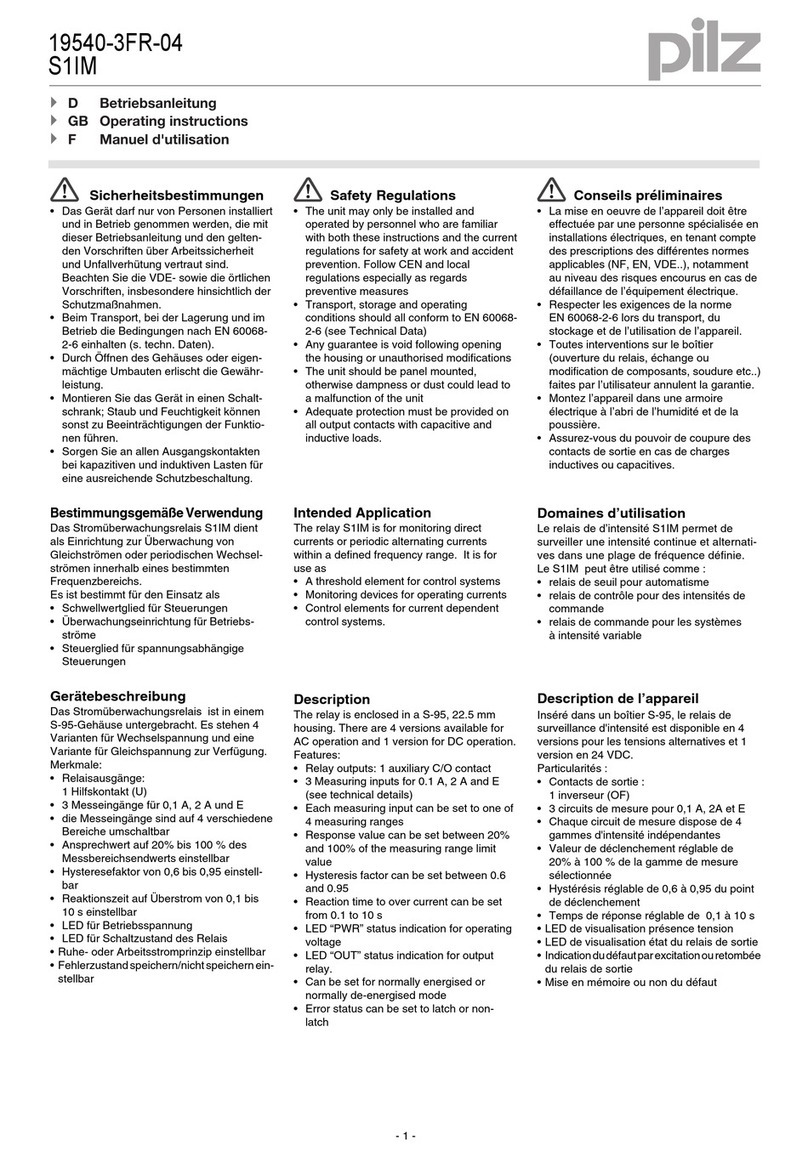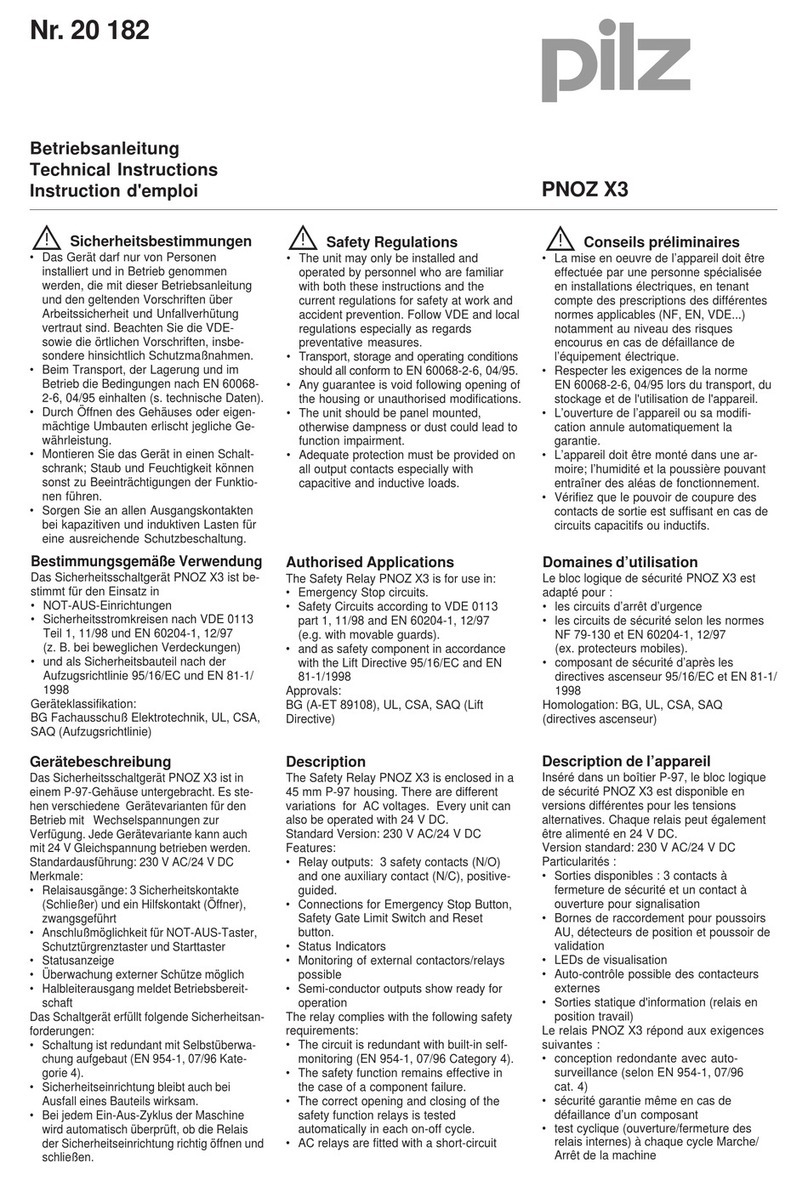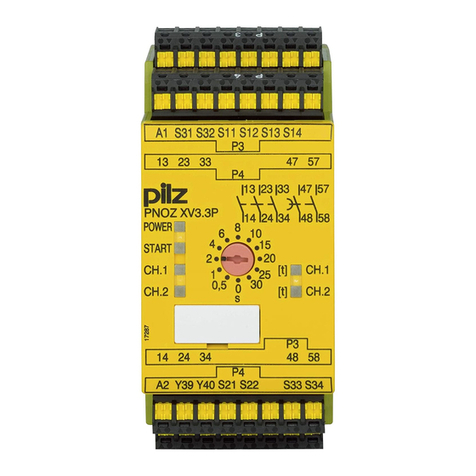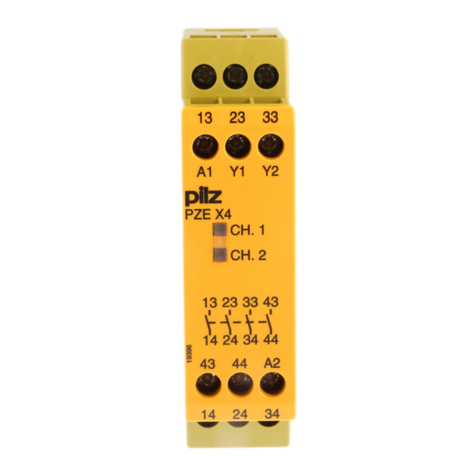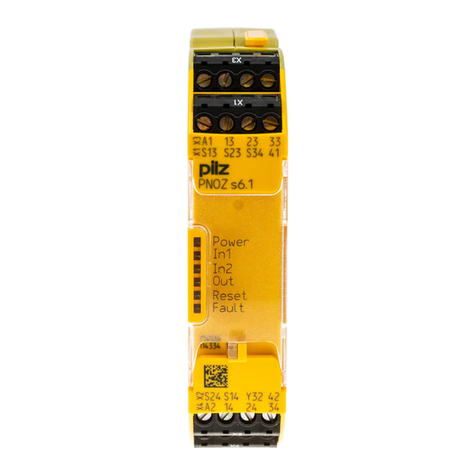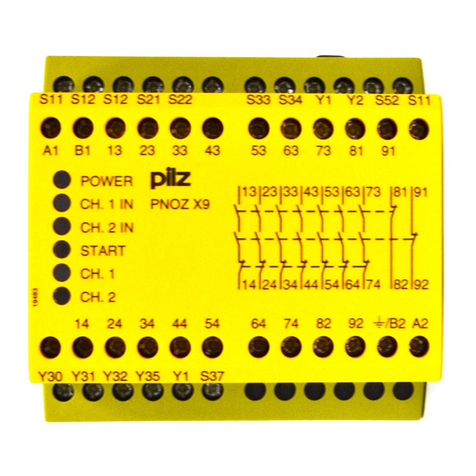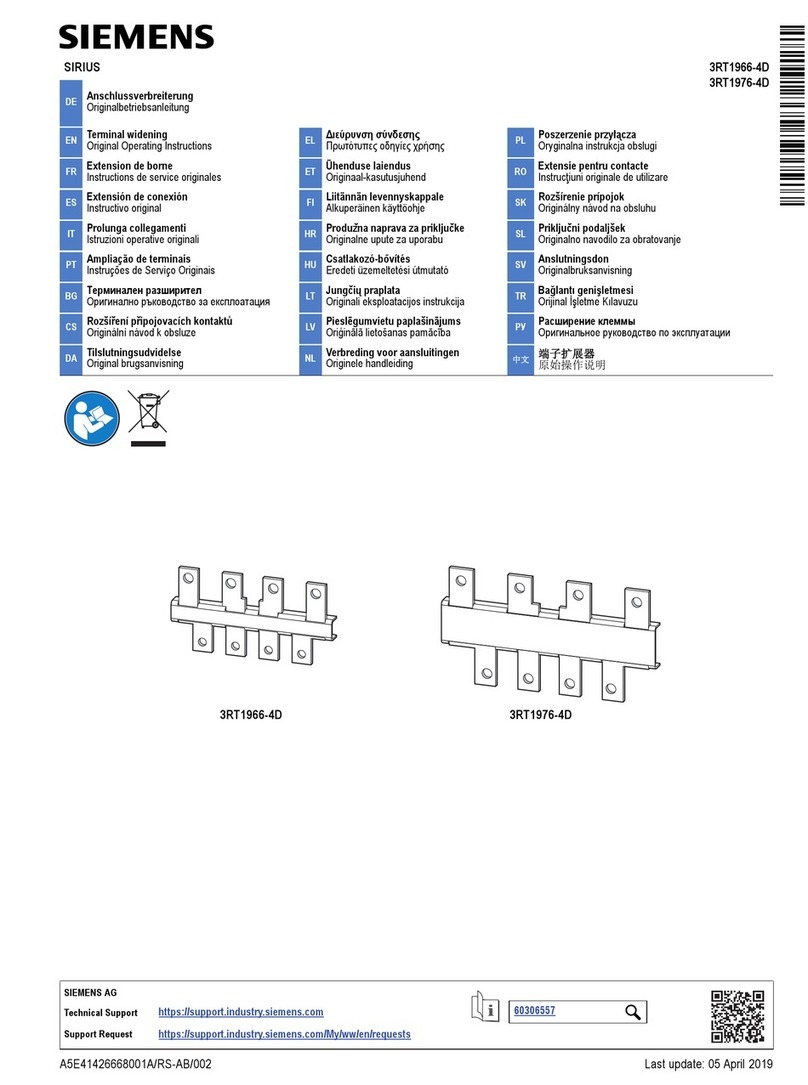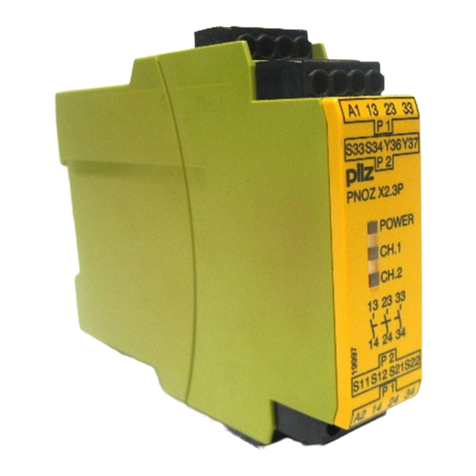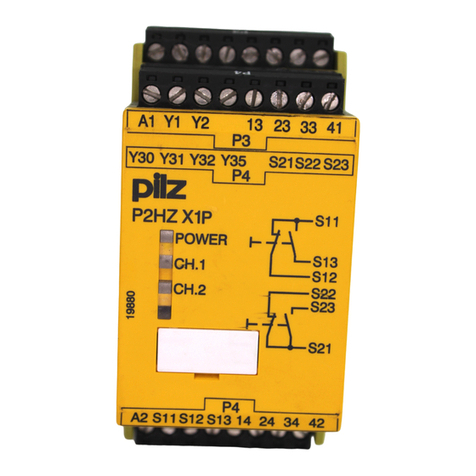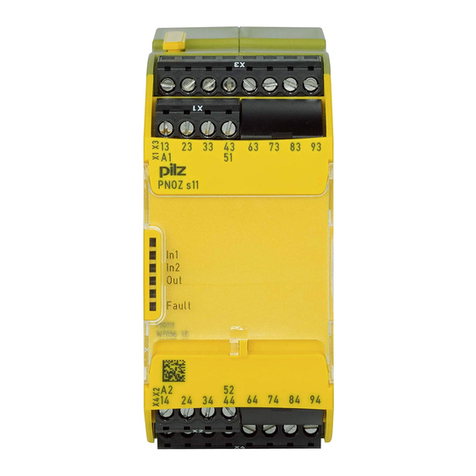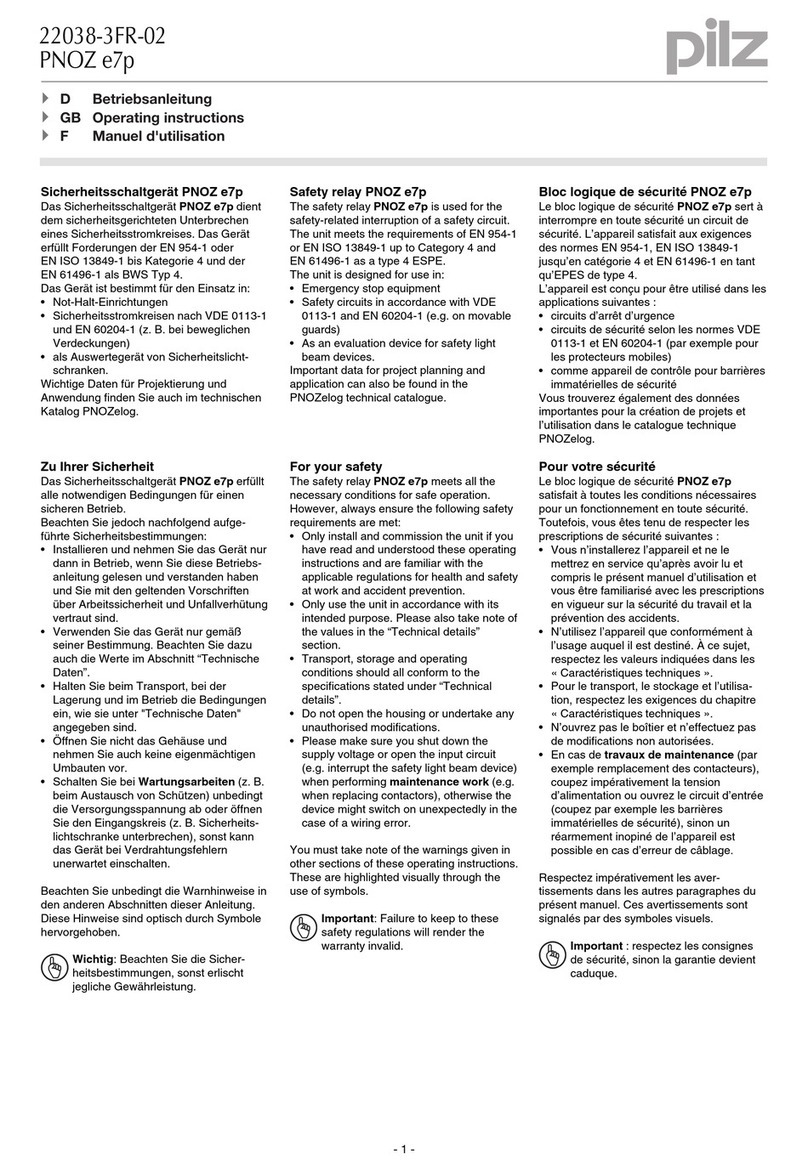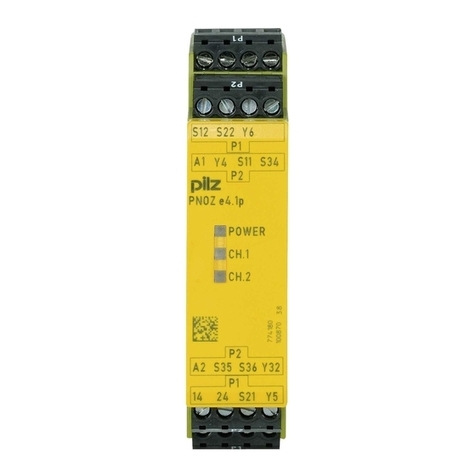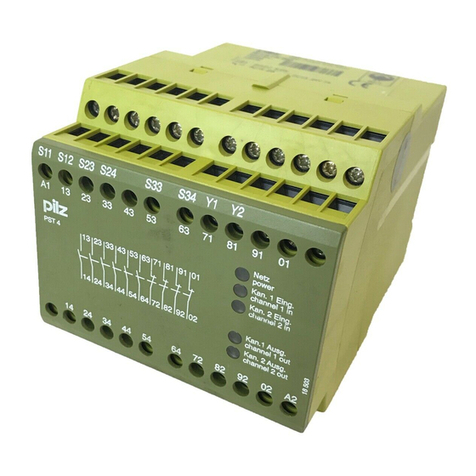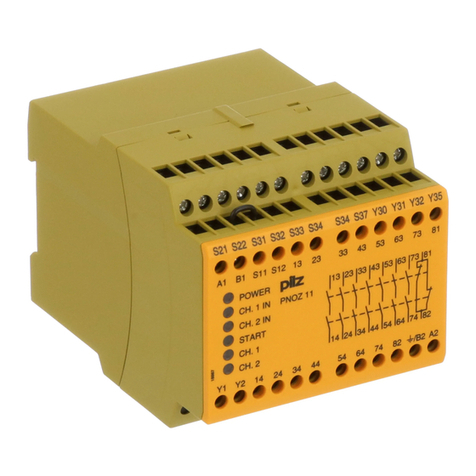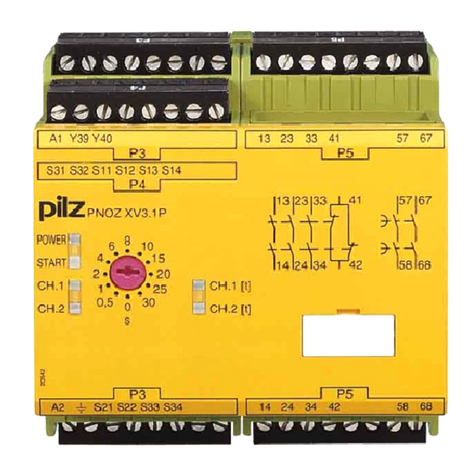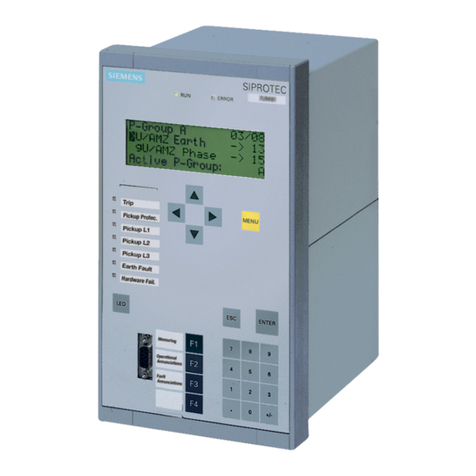
- 9 -
Prescripciones de seguridad
• El dispositivo tiene que ser instalado y
puesto en funcionamiento exclusivamente
por personas que estén familiarizadas tanto
con estas instrucciones de uso como con las
prescripciones vigentes relativas a la
seguridad en el trabajo y a la prevención de
accidentes. Hay que observar tanto las
prescripciones VDE como las prescripciones
locales, especialmente en lo que se refiere a
las medidas de protección.
• Durante el transporte, el almacenaje y el
funcionamiento hay que atenerse a las
condiciones conforme a EN 60068-2-6 (ver
datos técnicos).
• La garantía se pierde en caso de que se
abra la carcasa o se lleven a cabo modifica-
ciones por cuenta propia.
• Montar el dispositivo dentro de un armario de
distribución; en caso contrario es posible que
el polvo y la suciedad puedan afectar el
funcionamiento.
• Hay que cuidar de que haya un conexionado
de seguridad suficiente en todos los contactos
de salida con cargas capacitivas e inductivas.
• La función de seguridad debe ejecutarse
por lo menos una vez al mes.
Campo de aplicación adecuado
El dispositivo de seguridad PNOZ XV1P está
concebido para ser empleado en
• dispositivos de PARADA DE EMERGENCIA
• circuitos de seguridad según EN 60204-1
(VDE 0113, parte 1) y IEC 60204-1 (p. ej.
con cubiertas móviles)
Descripción del dispositivo
El dispositivo de PARADA DE EMERGENCIA
se encuentra montado dentro de una carcasa
S-99. Existe un modelo para el funcionamiento
con tensión continua de 24 V.
Características:
• Salidas de relé, sin retardo: 2 contactos de
seguridad (NA), de guiado mecánico
• Salida de relé, con retardo a la desconexión:
1 contacto de seguridad (NA), de guiado
mecánico, con retardo a la desconexión
ajustable
• Indicaciones de estado para tensión de
alimentación y estado de conmutación de
todos los canales de salida
• Conexión para pulsador de PARADA DE
EMERGENCIA, interruptor final de seguridad
o interruptor de puerta protectora y para
pulsador de rearme externo
• Conexión redundante de salida
• Modo monocanal o bicanal
• Circuito de realimentación para la supervi-
sión de contactores externos
El dispositivo cumple los requerimientos de
seguridad siguientes:
• La instalación de seguridad permanece
activa también cuando se presentan los
casos siguientes:
- Caída de la tensión
- Fallo de un elemento constructivo
- Defecto de bobina
- Rotura de línea
- Contacto a tierra
Norme di sicurezza
•
Il dispositivo può venire installato e messo
in funzione solo da persone che conosco-
no bene le presenti istruzioni per l’uso e le
disposizioni vigenti riguardo alla sicurezza
di lavoro e all’antinfortunistica. Osservare
le disposizioni della VDE nonché le norme
locali, soprattutto per quanto riguarda le
misure preventive di protezione.
• Durante il trasporto, l’immagazzinamento
e il funzionamento attenersi alle condizioni
prescritte dalla norma EN 60068-2-6 (v.
Dati tecnici).
• Se viene aperta la custodia oppure se
vengono apportate delle modifiche in
proprio decade qualsiasi diritto di
garanzia.
• Montare il dispositivo in un armadio
elettrico; altrimenti la polvere e l’umidità
possono pregiudicare le funzioni.
• Preoccuparsi che tutti i contatti di uscita
sui carichi capacitivi e induttivi siano dotati
di un circuito di sicurezza sufficiente.
• La funzione di sicurezza deve essere
attivata almeno una volta al mese.
Uso previsto
Il modulo di sicurezza PNOZ XV1P è
concepito per essere utilizzato in
• dispositivi di arresto di emergenza
• circuiti elettrici di sicurezza conformi alle
norme EN 60204-1 (VDE 0113 Parte 1) e
IEC 60204-1 (per es. in caso di protezioni
mobili)
Descrizione
Il modulo di arresto di emergenza è inserito
in un alloggiamento S-99. È disponibile una
versione per il funzionamento con corrente
continua 24 V.
Caratteristiche:
• Uscite relè, senza ritardo:
2 contatti di sicurezza (NA), con contatti
guidati
• Uscita relè, ritardato allo sgancio:
1 contatto di sicurezza (NA), con contatti
guidati, con ritardo di sgancio registrabile
• Visualizzazioni di stato per tensione di
alimentazione e stato di commutazione di
tutti i canali di uscita
• Collegamento per pulsante di arresto di
emergenza interruttore di fine corsa tasti
o interruttore riparo mobile e per pulsante
di start esterno
• Circuito d’uscita ridondante
• Funzionamento mono o bicanale
• Circuito di retroazione per il controllo di
relè esterni
Il dispositivo elettrico risponde ai seguenti
requisiti di sicurezza:
• La funzione di sicurezza rimane attiva
anche nei casi seguenti:
- Interruzione di tensione
- Guasto di un componente
- Difetto della bobina
- Interruzione di un conduttore
- Guasto a terra
Veiligheidsvoorschriften
• Het apparaat mag uitsluitend worden
geïnstalleerd en in bedrijf genomen door
personen die vertrouwd zijn met deze
gebruiksaanwijzing en met de geldende
voorschriften op het gebied van arbeids-
veiligheid en ongevallenpreventie. Neemt
u de van toepassing zijnde Europese
richtlijnen en de plaatselijke voorschriften
in acht, in het bijzonder m.b.t. veiligheids-
maatregelen.
• Neemt u bij transport, opslag en in bedrijf
de richtlijnen volgens EN 60068-2-6 in
acht (zie technische gegevens).
• Het openen van de behuizing of het
eigenmachtig veranderen van de
schakeling heeft verlies van de garantie
tot gevolg.
• Monteert u het apparaat in een schakel-
kast. Stof en vochtigheid kunnen anders
de werking nadelig beïnvloeden.
• Zorgt u bij capacitieve of inductieve
belasting van de uitgangscontacten voor
adequate contactbeschermings-
maatregelen.
• De veiligheidsfunctie moet ten minste een
keer per maand geactiveerd worden.
Toegelaten applicaties
Het veiligheidsrelais PNOZ XV1P is
bestemd voor gebruik in
• noodstopvoorzieningen
• veiligheidscircuits volgens EN 60204-1
(VDE 01131) en IEC 60204-1 (b.v. bij
beweegbare afschermingen)
Apparaatbeschrijving
Het noodstoprelais is in een S-99-behuizing
ondergebracht. Er is een uitvoering voor
bedrijf met 24 V gelijkspanning beschikbaar.
Kenmerken:
• Relaisuitgangen, niet-vertraagd:
2 veiligheidscontacten (M), mechanisch
gedwongen
• Relaisuitgang, afvalvertraagd:
1 veiligheidscontact (M), mechanisch
gedwongen, met instelbare afval-
vertraging
• Status-LED’s voor voedingsspanning en
schakeltoestand van alle uitgangskanalen
• Aansluiting voor noodstopknoppen,
veiligheidseindschakelaars of hek-
schakelaars en voor externe startknop
• Redundante uitgangsschakeling
• Een- of tweekanalig bedrijf
• Terugkoppelcircuit voor de bewaking van
externe magneetschakelaars
Het relais voldoet aan de volgende
veiligheidseisen:
• De veiligheidsschakeling blijft ook in de
volgende gevallen werken:
- uitvallen van de spanning
- uitvallen van een component
- defect in een spoel
- kabelbreuk
- aardsluiting
20 596-03
PNOZ XV1P
4E Instrucciones de uso
4I Istruzioni per l`uso
4NL Gebruiksaanwijzing

